#Roger Fenton Crimean War Photograph Collection
Photo
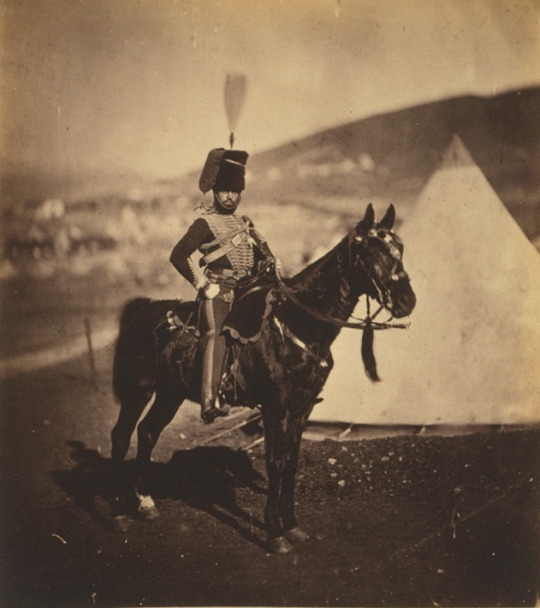
Title: Cornet Wilkin, 11th Hussars
Other Title: Cornet John Wilkin, 11th Hussars
Creator(s): Fenton, Roger, 1819-1869, photographer
Date Created/Published: [1855]
Summary: Henry John Wilkin, full-length portrait, wearing uniform, seated on a horse, a bell tent in the background.
Reproduction Number: LC-USZC4-9124 (color film copy transparency) LC-USZ62-47838 (b&w film copy neg.)
Rights Advisory: No known restrictions on publication.
Repository: Library of Congress Prints and Photographs Division Washington, D.C. 20540 USA http://hdl.loc.gov/loc.pnp/pp.print
Notes: Title transcribed from item. Alternate title from: James, Crimea 1854-56: the war with Russia from contemporary photographs. Purchase: Frances M. Fenton, 1944. Forms part of: Roger Fenton Crimean War photograph collection. Crimea 1854-56 : the war with Russia from contemporary photographs / Lawrence James. New York : Van Nostrand Reinhold, c1981, no. 11. Published in: "War" chapter of the ebook Great Photographs from the Library of Congress, 2013.
Library of Congress.
#Cornet Wilkin#11th Hussars#military history#cavalry#Crimea#Crimean War#1855#Roger Fenton#Library of Congress#Roger Fenton Crimean War Photograph Collection
14 notes
·
View notes
Text
5 Historical photographers.
Yousuf Karsh...
Yousuf Karsh was born in the Ottoman empire which is known know as Turkey. He was a survivor of Armenian genocide and escaped to Syria. He was Amernian /Canadian nationality and was sent to Canada. His most famous photo was of Sir Winston Churchill, the British prime minister that was taken in 1941 in the chambers of the ‘speaker of the house’ in the house of commons. Karsh has been recognised as one of Canada’s leading portrait photographers, or in general as the most well known.During world war 2, Karsh photographed many political and military leaders and also writers.He was also described by the Metropolitan Museum of art as one of the greatest portrait photographers of the twentieth century due to his theatrical style of lighting .Karsh’s work was on display on a permanent basis at the Metropolitan Museum and Museum of modern art by the time of his death. A bust of Karsh was a gift from Armenia and it depicted his famous camera.The National Archives of Canada acquired the full collection including his negatives,prints and transparencies produced by him since 1933 which has over 355,000 items including 150,00 of his negatives.


Ansel Adams.
Ansel Adams was a great landscape photographer who used black & white images to illustrate the American west,Born in America , His greatest works where of Yosemite National park & helped promote conservation of wilderness areas. Born in San Francisco in 1902 ,California. He helped found the f/64 club an association of photographers advocating pure photography which favored sharp focus and the full tonal range of a photograph.Adams was a great advocate for conservation and his photographs showed this.He was given a camera at an early age on his first visit to Yosemite National park.Adams received lots of awards not just for photography but also his conservation work that he done through out his lifetime and some where even named after him.His work is still exhibited all over the world to this date and will continue for many more years.One of his photographs was sold at Sotheby’s for over $722,000 in 2010 and is the highest price ever paid for by an original Ansel Adams photograph.


Robert Capa
Robert was a Hungarian born American war photographer & journalist. Born in 1913 He fled Hungary to Berlin and witnessed the rise of Hitler. Robert first achieved fame as a war correspondent during the Spanish civil war and produced grim close up views of death such as " Loyalist soldier " He risked his life on several occasions and was the only civilian photographer on the Omaha beach on D-.Day. He covered 5 wars during his time a as a photographer and his work was published in major magazines and newspapers.He also received a Medal of Freedom awarded to him by the then American president Dwight-D,Eisenhower.His legacy goes on and the Hungarian government issued a postage stamp in his honor and the same year they issued a 5,00 forint gold coin which showed an engraving of himself .
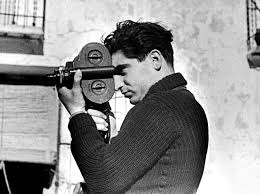
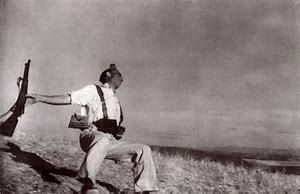
Roger Fenton
Roger is my favorite photographer and the first one that I had read up on. It amazed me how he managed to work with a mobile darkroom. He was British born and along with his assistant where paid by the British government to report on the Crimean War in 1853. Technology was at the basics and to have to travel around in a horse drawn caravan with all that equipment must have been really hard.He was born in 1819 and started late doing photography and was interested in painting and after graduating from The University London with a first class Bachelor of Arts degree.. In 1852 he started exhibiting his own work after seeing seeing early examples of photos at The Great Exhibition he went to Paris to learn about the Calotype process that had just been invented around that time .He done a lot of architecture photography in Britain and Kiev,Moscow and St Petersburg.
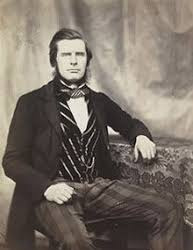
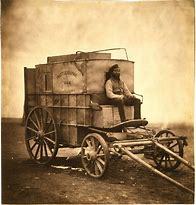
Andy Warhol
Andy Warhol was an American artist cum photographer who started the visual art movement known as pop art. He first held a camera when he was just a 10 year old child and used the families Brownie taking photos of his back yard of his house. He used Polaroids and black and white prints that mostly featured celebrities. Most people don’t class him as a photographer but as a painter but someone in between . His look on his photographs as to be a personal diary His art work has been valued at over $80 million dollars that has over 66,00 images and after a court trial it was concluded that he was a fine art photographer.His work is available all over the world in exhibition and will be for many more years to come.
camera.https://expertphotography.com/most-famous-photographers/
https://expertphotography.com/most-famous-photographers/


0 notes
Text

PASHA AND BAYADÈRE
ROGER FENTON
Genre Tableau
Date 1858
Location London, UK
Format Wet collodion negative
“Roger Fenton (1819-69)was one of the most important British photographers of the nineteenth century. He is best known for his pioneering work as a war photographer, and in 1855 Fenton visited Constantinople en route to photograph the Crimean War (1854-56). This visit was to inspire this photograph, which, despite initial apparences, is not a documentary image taken by Fenton during his travels but a carefully staged tableau photographed three years later in his London studio, using a model, costumes and props. A bayadère (dancing girl) performs for the enjoyment for the pasha, who watches her intently, entranced by her sinuous movement.
Seated on the floor, a musician accompanies her on a stringed instrument.
This image is one of a series of about fifty photos taken by Fenton during the summer of 1858; they are known collectively as his Orientalist Studies. Fenton himself appears as the bearded pasha, while the role of the musician is played by English landscape painter Frank Dillon, known especially for his paintings of Egypt.
Fenton hired a professional artist’s model to represent the dancing girl, but even an experienced model would not have been able to remain motionless in the required position for the long exposure time essential for the photograph.
Fenton came up with an ingenious idea to solve the problem - he suspended the model’s arms from the ceiling. Fenton tried to disguise this by retouching the negative, but a very close look reveals the string attached to her wrists - Artifice in the service of Art.”(CH)
————
‘This captivating tableau is of huge importance to the display and study of photography. The intriguing interplay between the characters and Fenton’s visual trickery are sure to fascinate viewers . . . ‘ Stephen Deuchar, director of the Art Fund, UK
—————-
#1001andmore #lillynisthartistconcept #1transcribedtext #1001beforeyoudiecollection #1001beforeyoudiecollections #oldphotograph
2 notes
·
View notes
Text
This spring Southeby’s will auction one of the earliest war photographs
<b>A QUIET DAY IN THE MORTAR BATTERY:</b> salt print from a wet collodion glass negative, mounted, with lithographed credit, title, date, 'No. 56,' and publisher's information on the mount, 1855, printed in 1856 (Roger Fenton/)
Sotheby’s has announced the items that will be part of it’s Spring auction, which includes 230 lots of photographic works with price estimates between $2,000 and $600,000. The artists such as Cindy Sherman, Irving Penn, Thomas Struth, and Helmut Newton.
The auction will also include a rare print from Roger Fenton’s Crimean War series. Created in 1855 the photos in the series are considered to be some of the earliest photographs depicting war. According to the auction house, this may be the first time that a print has appeared at auction. The print passed down through the Fenton family for nearly 150 years. Additional prints of the image belong to collections of MoMA, The Royal Collection, and the J. Paul Getty Museum.
Fenton was a leading British photographer and a founder of the Photographic Society. In 1855 he traveled with a small group of photographers to document what was happening on the battlefield in Crimea. Due to the nature of photographic materials at the time—which were very large and required a ton of light—Fenton’s photographs prominently featured stationary objects. A Quiet Day in the Mortar Battery depicts a group of soldiers lounging around waiting for some action. The salt print was created from a wet collodion glass negative, was printed in 1856 and features a lithographed credit. Sotheby’s estimates it will sell for as much as $120,000.
<b>MOTHER AND BABY OF FAMILY ON THE ROAD, TULELAKE, SISKIYOU COUNTY, CALIFORNIA:</b> with '20985-E' in pencil on the reverse, 1939 (Dorothea Lange/)
The auction will also feature a group of prints from Dorothea Lange, who is currently the subject of a retrospective at MoMA. The photos that will be on view at Sotheby’s before auction all come from her photographic survey of the effects of the Great Depression. The portraits include early prints of Six Tenant Farmers Without Farms, Goodlet, Hardeman County, Texas and Mother and Baby of Family on the Road, Tulelake, Siskiyou County, California. A later print of Women of the High Plans, Texas Panhandle, which was printed in preparation for her first MoMA retrospective will also be available. Sotheby’s estimates that these prints will sell for as much as $60,000.
<b>WOMAN OF THE HIGH PLAINS, TEXAS PANHANDLE:</b> large-format, framed, 1938, printed from the original negative circa 1965 under the direct supervision of the photographer for The Museum of Modern Art (Dorothea Lange/)
Although paying that much for a piece of art is certainly out of the price ranges of most, the work will be on view for the public starting on March 28 at Sotheby’s. Swing by before the auction on April 6 to see these prized pieces before they become the possessions of collectors.
from Popular Photography | RSS https://ift.tt/33eLACr
0 notes
Text
Photography - People throughout History
Joseph Nicéphore Niépce
Joseph is known for taking the first photograph ever. He took it from the window at ‘Le Gras’ in 1826 in the Burgundy region of France. In 1793, he and his brothers had first discussed using light to reproduce images however, it was a slow process as photography wasn't a main interest of his. Instead his primary interest was creating a boat propeller called the ‘Pyreolophore’. He spent most his time improving this invention. When the art of lithography was a craze, Joseph experimented and eventually this led to heliography. Heliography is a photographic process that enabled him to take the first photograph which can be seen below.
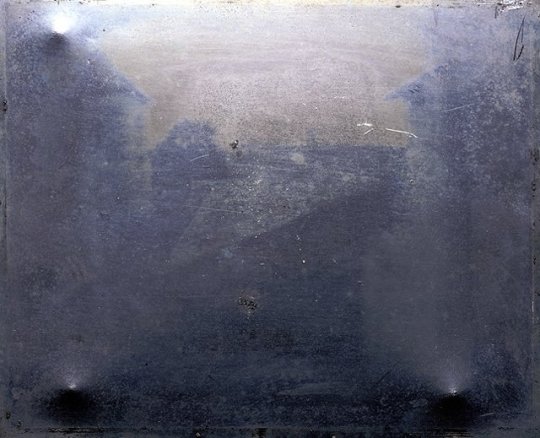
Louis Daguerre
Louis collaborated with Joseph Niepce to create the first practical and successful form of photography in the 1830′s. This process is called Daguerreotype. Previously Louis was partners with Joseph from the beginning of the development of Josephs heliographic process to his death.
After Josephs death Louis continued experimenting and was successful. He discovered that using an iodized silver plate in a camera would result in a lasting image if the non developed image on the plate was then developed by being exposed to fumes of mercury and then fixed by a solution of salt.
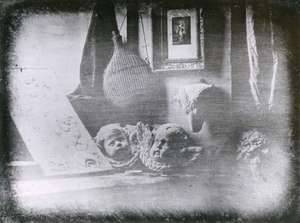
Matthew Brady
Brady is a 19th century photogrpaher best known for his photographs of the American Civil War. He opened multiple daguerreotype studios in the US. Here he decided to try and photograph portraits of as many famous people of his time as he could. He even had a collection of presidential portraits. These portraits gave him fame at home and abroad.
Matthew once said, “My greatest aim, has been to advance the art of photography and to make it what I think I have, a great and truthful medium of history.” Therefore when the American Civil War began he hired 20 photographers and spread them amongst war zones to take photos. When the government didn't buy his photos he went bankrupt, he never regained his finial state and died alone, forgotten in a hospital charity ward.





Roger Fenton
Fenton is best known for his photos of the Crimean War. His mission to take the photos was encouraged by the government in the hope that his photos would reassure a worried public. Originally, he photographed architecture and landscapes in which he had a great ability to photograph with the correct lighting and vantage point allowing the viewer to notice the smaller details in photos of architecture for example.


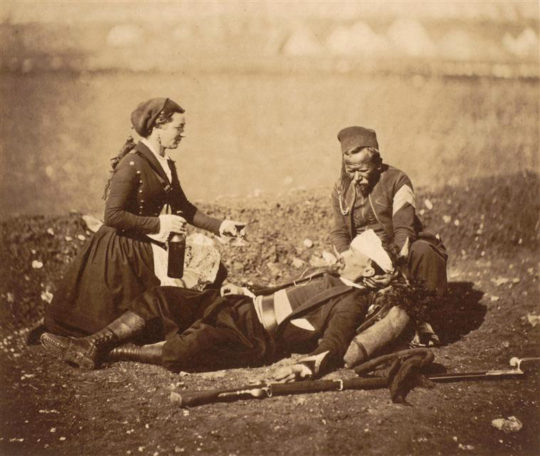

0 notes
Text
Hyperallergic: Art Movements
Roger Fenton, “Photographic Van” (1855), albumen print, 17.4 x 15.9 cm (courtesy Royal Collection Trust, © Her Majesty Queen Elizabeth II 2017)
Art Movements is a weekly collection of news, developments, and stirrings in the art world. Subscribe to receive these posts as a weekly newsletter.
Israeli authorities arrested five Palestinian antiquities dealers in Jerusalem and confiscated a number of items, including a papyrus fragment from the Egyptian Book of the Dead, a fresco from Pompeii, two luxury Audi vehicles, and over $200,000 in cash. According to NPR, Israel’s Antiquities Authority claim that the five dealers were involved in the sale of looted antiquities to Hobby Lobby.
Six former government officials in South Korea received prison sentences for blacklisting thousands of artists and cultural figures from government-controlled cultural programs. The scandal contributed toward the impeachment of president Park Geun-hye in December.
The Metropolitan Museum of Art returned two looted antiquities; a 4th-century BCE terracotta vase and a 5th-century BCE marble sculpture of a bull’s head.
Syrian-Palestinian web developer and cyberactivist Bassel Khartabil was executed by the Syrian government in 2015, according to an announcement by his wife Noura Ghazi Safadi. Khartabil, a Creative Commons advocate, also founded #NEWPALMYRA, a community driven project dedicated to the “reconstruction of Palmyra in virtual space.”
Shadows of War: Roger Fenton’s Photographs of the Crimea 1855 — the first exhibition of the Victorian photographer’s work in Scotland since 1856 — opened at the at Queen’s Gallery at the Palace of Holyroodhouse. Fenton’s images of the Crimean War were the first war photographs to be widely reproduced and viewed by the British public. According to the Guardian, the show includes multimedia contributions by Prince Harry.
Archaeologists in the city of Vienne in southern France have discovered a 75,000-square-foot Roman neighborhood dating from the first century CE.
The Artist Pension Trust revealed plans to charge a monthly storage fee for artists, prompting many of its members to launch an online campaign group opposing the fees.
Thomas Gainsborough, “The Blue Boy” (ca. 1770), oil on canvas, 70 5/8 x 48 3/4 inches, The Huntington Library, Art Collections, and Botanical Gardens (via Wikipedia)
The Huntington Library, Art Collections, and Botanical Gardens announced that Thomas Gainsborough’s “The Blue Boy” (1770) will undergo its first major conservation treatment. The final phase of the project will take place in full public view as part of an exhibition entitled Project Blue Boy.
Russian foreign ministry officials threatened Poland with sanctions after the country updated its “de-communisation” legislation. The policy calls for the ban of all totalitarian symbols, including Soviet monuments.
A 67-year-old woman was arrested in Mallorca for stealing a Jean-Michel Basquiat painting from a collector in Alcúdia.
Recent activity suggests that North Korea may finally complete the Ryugyong Hotel, currently the world’s tallest unoccupied structure. Dubbed by Western media as the “Hotel of Doom,” the 105-storey pyramid has been under construction since 1987.
The Canadian Cultural Property Export Review Board declined to certify a gift of Annie Leibovitz photographs donated to the Art Gallery of Nova Scotia in 2013. The Toronto-based Mintz family purchased the collection of 2,070 photographs for $4.75 million. The gift was described as a “tax grab” by an advisor appointed to review the donation, after it was appraised with a total value of $20 million — a figure four times the collection’s purchase price.
A group of Aboriginal rangers discovered thousands of pieces of rock art while conducting dry-season burn-offs in Australia’s West Arnhem region.
Transactions
Jennifer Allora and Guillermo Calzadilla, “Petrified Petrol Pump (Pemex II)” (2011), black lava and travertine stone, 254 x 203.2 x 203.2 cm (courtesy the artist and kurimanzutto, Mexico City)
The Bass acquired Jennifer Allora and Guillermo Calzadilla’s “Petrified Petrol Pump (Pemex II)” (2011).
The National Endowment for the Humanities announced $39.3 million in grants for 245 projects across the US — the final round of grants for fiscal year 2017.
The Graham Foundation awarded over $400,000 in grants to 41 architectural projects.
The National Museum of American Jewish History acquired a collection of sculptures from Phillip Ratner’s Ellis Island Immigrants series.
The New-York Historical Society acquired Barney Tobey’s original illustrations for Chitty Chitty Bang Bang! The Magical Car (1968).
As part of its “Keeping It Modern” initiative, the Getty Foundation awarded $1.66 million in architectural preservation grants to 12 buildings from the 20th century, including the Bauhaus Building in Dessau and the Price Tower, Frank Lloyd Wright’s only skyscraper.
The Arthayer R. Sanborn Hopper Collection Trust donated a collection of Edward Hopper archive material to the Whitney Museum of American Art.
Edward Hopper’s “Notes on Painting” notebook (cover) (ca 1940–50), the Sanborn Hopper Archive at the Whitney Museum of American Art, Frances Mulhall Achilles Library, Gift of The Arthayer R. Sanborn Hopper Collection Trust
Transitions
May Calil, Chris Evans, Jonathan Falkingham, Sandeep Parmar and Anna Valle were appointed to the Liverpool Biennial‘s board of trustees.
Vicki Coltman, Sarah Davies, and Fiona Jose were appointed to the National Museum of Australia’s governing council.
Bill Sherman was appointed director of the Warburg Institute.
Nadine Wietlisbach was appointed director of the Fotomuseum Winterthur.
Dennis Scholl was appointed president and chief executive of the nonprofit ArtCenter/South Florida.
Della Watkins was appointed executive director of the Columbia Museum of Art.
Dale Dobson was appointed interim executive director of the Maysles Documentary Center [via email announcement].
David Galligan will step down as deputy director and COO of the Walker Art Center in September.
The Metropolitan Museum of Art announced five new senior staff appointments.
Keith L. Prewitt, the former deputy director of the United States Secret Service, was appointed chief security officer of the Metropolitan Museum of Art.
Linda Butler was appointed director of marketing, communications, and visitor experience at the Fine Arts Museums of San Francisco.
Michelle Elligott was appointed chief of archives, library, and research collections at the Museum of Modern Art.
Theodore Ward Barrow was appointed assistant curator at the Hudson River Museum.
ProjectArt appointed Chana Budgazad Sheldon as director for Miami and national program advisor.
Javier Pes will step down as editor of The Art Newspaper in the fall.
Phillips promoted Kaeli Deane to vice president and head of department, Americas, for Latin American Art [via email announcement].
The first International Biennial of Contemporary Art of South America (BienalSur), will launch across 30 cities next month.
New York’s Marinaro Gallery will relocate to Chinatown in September.
The Postal Museum opened in London.
Accolades
Mitch Cairns received the 2017 Archibald Prize.
The Asia Art Archive awarded Robert HN Ho Family Foundation Greater China Research Grants to Belinda Qian, Duan Ziying, and Liu Nanxi.
National Geographic announced the winners of Travel Photographer of the Year.
Opportunities
Rhizome is currently accepting applications for its 2017 Microgrants. The program is “for the creation of new artworks, online exhibitions, and other web-based projects.”
Obituaries
A photograph of Twiggy by Gösta Peterson. The image appeared in The Times Magazine on April 16, 1967. (courtesy TURN Gallery)
Bill Collings (1948–2017), guitar maker.
Pamela Engel (1934–2017), film distributor. Co-owner of Artificial Eye.
June Foray (1917–2017), voice actor. Best known as Rocky in The Bullwinkle Show.
Geoffrey Godbert (1937–2017), poet and editor. Co-founder of the Greville Press.
Igor Golomstock (1929–2017), art historian and writer. Best known for Totalitarian Art (1990).
Ian Graham (1923–2017), epigraphist.
Judith Jones (1924–2017), editor.
Ebony McKinney (unconfirmed–2017), arts advocate. Helped spearhead Emerging Arts Professionals/San Francisco Bay Area (EAP/SFBA) and Arts for a Better Bay Area (ABBA).
DL Menard (1932–2017), country singer and songwriter.
Jeanne Moreau (1928–2017), actor. Best known for her role in Jules et Jim (1962).
John G. Morris (1916–2017), photo editor.
Gösta Peterson (1923–2017), fashion photographer.
Concetto Pozzati (1935–2017), painter and former cultural advisor to the city of Bologna.
Sam Shepard (1943–2017), playwright and actor. Best known for Curse of the Starving Class (1977) and Buried Child (1979).
Harold M. Williams (1928–2017), founding president and CEO of the J. Paul Getty Trust.
Mark Wohlwender (unconfirmed–2017), photographer and picture editor.
The post Art Movements appeared first on Hyperallergic.
from Hyperallergic http://ift.tt/2uqZC0M
via IFTTT
0 notes
Photo


“My attachment to the idea of landscape is a direct extension of a life in exile.”An-My Lê
Marian Goodman Gallery Paris is pleased to present the first exhibition of An-My Lê’s work in France. Born in Saigon in 1960, as a child, An-My Lê spent several years in Paris, a city where her parents had lived and were married in the late 1950s. In 1975, in the wake of the war, her family left Vietnam permanently and emigrated to the United States. In the mid-1980s, she worked in France as a photographer for the Compagnons du Devoir. Over the course of four years, she documented architectural restorations and inventoried historical monuments, just as Eugène Atget had done in his time. This seminal experience, along with the artist’s personal history, influenced her deeply humanist oeuvre. “I aspire to achieve a certain lyrical objectivity. It is more about patterns of behavior than the specificity of it, which perhaps allows for a larger understanding of history and culture.”
For her first solo exhibition in Paris, An-My Lê presents The Silent General, a collection of new color photographs, first unveiled a few weeks ago at the Whitney Biennale in New York (on view until June 11, 2017). She is also showing blackand-white images from earlier series, including Viêt Nam, Small Wars, and 29 Palms.
An-My Lê’s latest project, The Silent General, takes its title from a fragment of Walt Whitman’s Specimen Days which is devoted to the American general and statesman Ulysses S. Grant. In this poetic autobiographical narrative, written in 1882, which blends personal history and national events, the author sets down his memories of the Civil War era (1861–65). The seven photographs made over the past two years in various places near or in New Orleans, Louisiana, are evocative of Whitman’s essay. The images are the result of the observation of different aspects of contemporary life in the South. However, in contrast to the photojournalist aesthetic always in close proximity to the subject, Lê keeps a distance, following the tradition of nineteenth-century landscape photography. Allusions to the past are woven into the scenery: the film set whose action unfolds against the backdrop of a famous Civil War battle, or a statue commemorating a Confederate army general. Other pictures represent archetypal motifs from American Southern history and heritage, such as a sugar cane field, churchgoers leaving the service, or anonymous laborers at work. The Silent General reveals just how much history continues to mark the territory and the people who inhabit it, and neatly encapsulates An-My Lê’s ambition: “Instead of seeking the real, I began to ground the imaginary. The landscape genre or the description of people’s activity in the landscape lent itself well to this way of thinking.”
29 Palms (2003–04) and Small Wars (1999–2002), together with Viêt Nam (1994–98), retrospectively compose a trilogy. 29 Palms follows the US Marine Corps training camp located in the high deserts of California. For months at a time, An-My Lê observed soldiers training before they were sent on a mission to Iraq or Afghanistan. Using an unwiedly large-format camera and 5×7 inch negatives, Lê mainly captured the soldiers in moments of rest or inactivity: she emphasized scale and the natural surroundings in which they interacted, adopting the approach taken by such early war reporters as Roger Fenton who, during the Crimean War (1853 -56) would only take “decent” pictures of the front lines – that is to say, free of any violence or direct combat. In so doing, Lê photographed a kind of fabricated situation or collective fiction. The expansive 29 Palms training grounds have been utilized by the US military since the 1960s but its eerie topographic and climatic similarities to regions of Iraq and Afghanistan approximate an uncanny theater of war for the conflicts in the Middle East. The photographer reveals the camp as a simulacrum, in the way that Jean Baudrillard defines it: “The simulacrum is never that which conceals the truth—it is the truth which conceals that there is none. The simulacrum is true.”
The series Small Wars similarly hinges on this ambiguity, and an uninformed viewer could be misled as to the nature of the images. For four consecutive summers, Lê “infiltrated” a group of individuals who, as a hobby, reenact, as accurately as possible, Vietnam War battles in Virginia and North Carolina. To gain better access to their “playground”, An-My Lê actively took part in their training sessions, agreeing to play various “enemy” roles, disguised as a member of the Viet Cong or a Vietnamese People’s Army soldier. Her photographs neither cast judgment on this pastime, nor on the people who engage in it; rather, they challenge our views of how a war may be commemorated. “Many people find the attitude of Vietnam War reenactors disturbing. And yet, by comparison, Hollywood’s obsession with films incessantly staging this war doesn’t seem to bother anybody. In my opinion, the fascination originates in the dialog between experience and chaos versus memory and fabrication which develops between these two worlds.” As in her other series, Lê is particularly attentive to the natural environment. “Working with the Vietnam war reenactors I became fascinated by the significance of the landscape in terms of strategic meaning. Every hilltop, bend in the road, group of trees, and open field became a possibility for an ambush, an escape route, a landing zone, or a campsite.”
The exhibition extends to Librairie Marian Goodman to include An-My Lê’s first photographic project devoted to Vietnam, carried out eighteen years after her exile and departure. The compositions are no longer located at the intersection of fiction and reality, but instead at the junction of two realities: the country’s own reality and that of An-My Lê’s memories. While the initial idea was to retrace her childhood and produce autobiographic still-lifes, the project took on a life of its own, and evolved into a sensitive portrait of a land where she traveled between city and countryside, and between North (Hanoi and the areas where her mother’s family came from) and South (Hô Chi Minh City, formerly Saigon the state capital where she was born).
An-My Lê lives and works in Brooklyn, New York. A graduate of Stanford University, she also holds a Masters of Fine Arts from the Yale University School of Art. She is a professor of Photography at Bard College in New York where she has taught since 1999. She has had solo exhibitions at several museums in the United States, including the Baltimore Museum of Art in 2013; Dia: Beacon in 2006–07; and MoMA PS1 Contemporary Art Center in New York in 2002. From 2006 to 2008 her exhibition Small Wars was featured at a dozen museums around the United States and Great Britain, including the San Francisco Museum of Art and the Museum of Contemporary Photography, Colombia College, in Chicago. In France, her work was featured in the group exhibition Topographies de la Guerre at Le BAL in Paris in 2011.
An-My Lê is the recipient of numerous awards and grants: in 2012 she was awarded the John D. and Catherine T. MacArthur Foundation Fellowship; in 2010, the Louis Comfort Tiffany Foundation Award; and in 2004 the John Gutmann Photography Fellowship. An-My Lê’s photographs belong to the collections of such international institutions as the Museum of Modern Art, the Metropolitan Museum of Art in New York, the Museum of Contemporary Photography in Chicago, as well as the Bibliothèque Nationale de France in Paris.
0 notes
Link
Artist: An-My Lê
Venue: Marian Goodman, Paris
Exhibition Title: The Silent General
Date: April 20 – May 27, 2017
Click here to view slideshow
Full gallery of images, press release and link available after the jump.
Images:
Images courtesy of Marian Goodman, Paris. Photos by Rebecca Fanuele.
Press Release:
“My attachment to the idea of landscape is a direct extension of a life in exile.”An-My Lê
Marian Goodman Gallery Paris is pleased to present the first exhibition of An-My Lê’s work in France. Born in Saigon in 1960, as a child, An-My Lê spent several years in Paris, a city where her parents had lived and were married in the late 1950s. In 1975, in the wake of the war, her family left Vietnam permanently and emigrated to the United States. In the mid-1980s, she worked in France as a photographer for the Compagnons du Devoir. Over the course of four years, she documented architectural restorations and inventoried historical monuments, just as Eugène Atget had done in his time. This seminal experience, along with the artist’s personal history, influenced her deeply humanist oeuvre. “I aspire to achieve a certain lyrical objectivity. It is more about patterns of behavior than the specificity of it, which perhaps allows for a larger understanding of history and culture.”
For her first solo exhibition in Paris, An-My Lê presents The Silent General, a collection of new color photographs, first unveiled a few weeks ago at the Whitney Biennale in New York (on view until June 11, 2017). She is also showing blackand-white images from earlier series, including Viêt Nam, Small Wars, and 29 Palms.
An-My Lê’s latest project, The Silent General, takes its title from a fragment of Walt Whitman’s Specimen Days which is devoted to the American general and statesman Ulysses S. Grant. In this poetic autobiographical narrative, written in 1882, which blends personal history and national events, the author sets down his memories of the Civil War era (1861–65). The seven photographs made over the past two years in various places near or in New Orleans, Louisiana, are evocative of Whitman’s essay. The images are the result of the observation of different aspects of contemporary life in the South. However, in contrast to the photojournalist aesthetic always in close proximity to the subject, Lê keeps a distance, following the tradition of nineteenth-century landscape photography. Allusions to the past are woven into the scenery: the film set whose action unfolds against the backdrop of a famous Civil War battle, or a statue commemorating a Confederate army general. Other pictures represent archetypal motifs from American Southern history and heritage, such as a sugar cane field, churchgoers leaving the service, or anonymous laborers at work. The Silent General reveals just how much history continues to mark the territory and the people who inhabit it, and neatly encapsulates An-My Lê’s ambition: “Instead of seeking the real, I began to ground the imaginary. The landscape genre or the description of people’s activity in the landscape lent itself well to this way of thinking.”
29 Palms (2003–04) and Small Wars (1999–2002), together with Viêt Nam (1994–98), retrospectively compose a trilogy. 29 Palms follows the US Marine Corps training camp located in the high deserts of California. For months at a time, An-My Lê observed soldiers training before they were sent on a mission to Iraq or Afghanistan. Using an unwiedly large-format camera and 5×7 inch negatives, Lê mainly captured the soldiers in moments of rest or inactivity: she emphasized scale and the natural surroundings in which they interacted, adopting the approach taken by such early war reporters as Roger Fenton who, during the Crimean War (1853 -56) would only take “decent” pictures of the front lines – that is to say, free of any violence or direct combat. In so doing, Lê photographed a kind of fabricated situation or collective fiction. The expansive 29 Palms training grounds have been utilized by the US military since the 1960s but its eerie topographic and climatic similarities to regions of Iraq and Afghanistan approximate an uncanny theater of war for the conflicts in the Middle East. The photographer reveals the camp as a simulacrum, in the way that Jean Baudrillard defines it: “The simulacrum is never that which conceals the truth—it is the truth which conceals that there is none. The simulacrum is true.”
The series Small Wars similarly hinges on this ambiguity, and an uninformed viewer could be misled as to the nature of the images. For four consecutive summers, Lê “infiltrated” a group of individuals who, as a hobby, reenact, as accurately as possible, Vietnam War battles in Virginia and North Carolina. To gain better access to their “playground”, An-My Lê actively took part in their training sessions, agreeing to play various “enemy” roles, disguised as a member of the Viet Cong or a Vietnamese People’s Army soldier. Her photographs neither cast judgment on this pastime, nor on the people who engage in it; rather, they challenge our views of how a war may be commemorated. “Many people find the attitude of Vietnam War reenactors disturbing. And yet, by comparison, Hollywood’s obsession with films incessantly staging this war doesn’t seem to bother anybody. In my opinion, the fascination originates in the dialog between experience and chaos versus memory and fabrication which develops between these two worlds.” As in her other series, Lê is particularly attentive to the natural environment. “Working with the Vietnam war reenactors I became fascinated by the significance of the landscape in terms of strategic meaning. Every hilltop, bend in the road, group of trees, and open field became a possibility for an ambush, an escape route, a landing zone, or a campsite.”
The exhibition extends to Librairie Marian Goodman to include An-My Lê’s first photographic project devoted to Vietnam, carried out eighteen years after her exile and departure. The compositions are no longer located at the intersection of fiction and reality, but instead at the junction of two realities: the country’s own reality and that of An-My Lê’s memories. While the initial idea was to retrace her childhood and produce autobiographic still-lifes, the project took on a life of its own, and evolved into a sensitive portrait of a land where she traveled between city and countryside, and between North (Hanoi and the areas where her mother’s family came from) and South (Hô Chi Minh City, formerly Saigon the state capital where she was born).
An-My Lê lives and works in Brooklyn, New York. A graduate of Stanford University, she also holds a Masters of Fine Arts from the Yale University School of Art. She is a professor of Photography at Bard College in New York where she has taught since 1999. She has had solo exhibitions at several museums in the United States, including the Baltimore Museum of Art in 2013; Dia: Beacon in 2006–07; and MoMA PS1 Contemporary Art Center in New York in 2002. From 2006 to 2008 her exhibition Small Wars was featured at a dozen museums around the United States and Great Britain, including the San Francisco Museum of Art and the Museum of Contemporary Photography, Colombia College, in Chicago. In France, her work was featured in the group exhibition Topographies de la Guerre at Le BAL in Paris in 2011.
An-My Lê is the recipient of numerous awards and grants: in 2012 she was awarded the John D. and Catherine T. MacArthur Foundation Fellowship; in 2010, the Louis Comfort Tiffany Foundation Award; and in 2004 the John Gutmann Photography Fellowship. An-My Lê’s photographs belong to the collections of such international institutions as the Museum of Modern Art, the Metropolitan Museum of Art in New York, the Museum of Contemporary Photography in Chicago, as well as the Bibliothèque Nationale de France in Paris.
Link: An-My Lê at Marian Goodman
Contemporary Art Daily is produced by Contemporary Art Group, a not-for-profit organization. We rely on our audience to help fund the publication of exhibitions that show up in this RSS feed. Please consider supporting us by making a donation today.
from Contemporary Art Daily http://bit.ly/2rVxVNy
0 notes
Photo
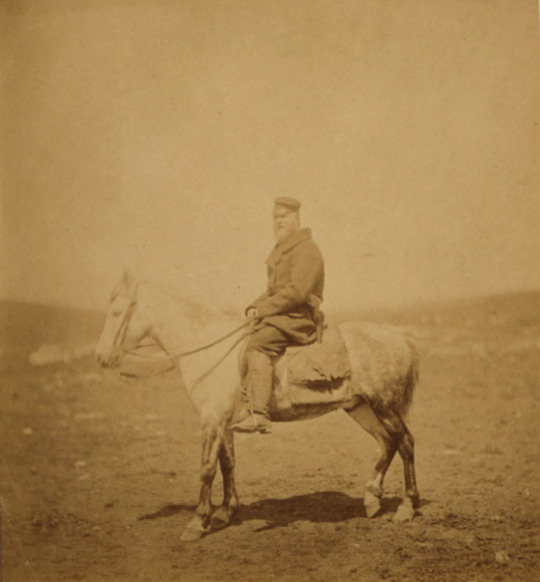
Title: Captain Chawner
Creator(s): Fenton, Roger, 1819-1869, photographer
Date Created/Published: [1855]
Summary: Captain Chawner, full-length portrait, seated on horse, facing left.
Reproduction Number: LC-USZC4-9360 (color film copy transparency)
Rights Advisory: No known restrictions on publication.
Repository: Library of Congress Prints and Photographs Division Washington, D.C. 20540 USA
Notes: Title transcribed from verso. Purchase; Frances M. Fenton; 1944. Forms part of: Roger Fenton Crimean War photograph collection.
Library of Congress,
#Crimea#Crimean War#military history#Captain Chawner#1855#Roger Fenton#Library of Congress#Roger Fenton Crimean War Photograph Collection
7 notes
·
View notes
Photo
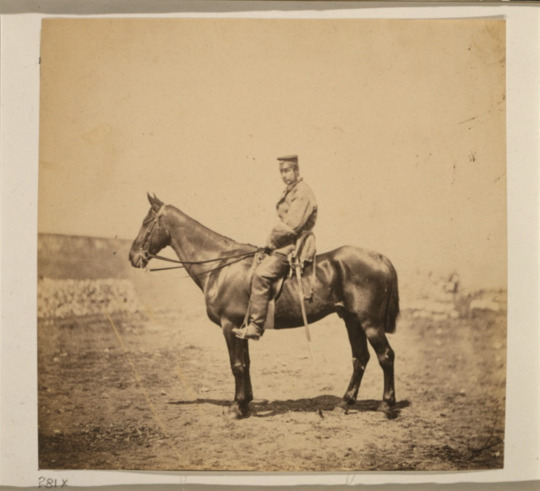
Title: Captain Pechell, 77th
Creator(s): Fenton, Roger, 1819-1869, photographer
Date Created/Published: [1855]
Summary: Captain Pechell, full-length portrait, seated on horse, facing left.
Reproduction Number: LC-USZC4-9356 (color film copy transparency)
Rights Advisory: No known restrictions on publication.
Repository: Library of Congress Prints and Photographs Division Washington, D.C. 20540 USA
Notes: Title transcribed from verso; Purchase: Frances M. Fenton, 1944; Forms part of: Roger Fenton Crimean War photograph collection.
Library of Congress
#military history#Crimean War#Crimea#Captain Pechell#1855#Roger Fenton#Library of Congress#Roger Fenton Crimean War Photograph Collection
3 notes
·
View notes
Text
Hyperallergic: Why Victorian Men Had Glorious Beards
Man with a beard in Brighton (1895) (courtesy private collection)
Charles Darwin had a grand white beard; Alfred Lord Tennyson had a fine mustache above his grizzled chin; Charles Dickens had his signature “door knocker” whiskers; Dante Gabriel Rossetti had a bushy goatee; and Caspar David Friedrich had rather wild mutton chops. Just about every Victorian man in Great Britain, and many in the United States, had elaborate facial hair, with even Prince Albert maintaining a neat mustache. Why were beards such a popular male facial hair style in the 19th century, and why are our pop culture icons and political leaders mostly clean-shaven now?
Fisherman from Whitby (courtesy the Sutcliffe Gallery)
One factor that’s explored in The Age of the Beard: Putting on a Brave Face in Victorian Britain at the Florence Nightingale Museum in London is the Crimean War of 1853–56. Florence Nightingale got her “Lady with the Lamp” nickname through her tending to wounded Crimean War soldiers by night, and when those soldiers returned home with their regal, manly manes, they contributed to a new enthusiasm for beards in the UK.
“The exhibition looks at the range of different facial hair styles in the Victorian period, and the meanings that they could carry,” University of Exeter historian Dr. Alun Withey, curator of The Age of the Beard, told Hyperallergic. “For example, there are portraits of heavily bearded soldiers in the Crimean War, who were some of the main heroes and role models for men in that period, and in fact partly sparked the 19th-century beard movement. We’ve got some of the more unusual styles — like the chin-strap and Dundreary whiskers — which show how there was no single beard style in the Victorian period, and how it evolved into lots of different looks.”
The Age of the Beard uses 19th-century photographs to explore these looks, from the flamboyant to the dignified. The era, with its snake oils and tonics, also saw plenty of potions for beard growth and coloring, as well as false beards and mustaches — sometimes made from goat hair — for those baby-faced gents unable to grow their own. And it wasn’t only for aesthetics; with the bad air of the Industrial Revolution, beards were seen as pollution-strainers.
Crimean War officers (1854–56) (photo by Robertson James, via Imperial War Museums/Wikimedia)
Officers of the 71st Highlanders in the Crimean War (photo by Roger Fenton, via Sotheby’s/Wikimedia)
The exhibition follows Withey’s Wellcome Fund-supported research project, “Do beards matter? Facial hair, health, and hygiene in Britain, c 1700–1918,” which considered this changing context. While the arrival of the disposable razor, and later soldiers in World War I needing to shave in order to wear their gas masks, the prominence of the British and American beard receded. Nevertheless, Withey doesn’t see the recent resurgence of beards as a niche, hipster choice.
“In fact, I’d argue that, for the first time in a very long time, they’ve become mainstream and normalized,” Withey said. “They’re not a reaction to anything now, and instead have become an acceptable part of a man’s appearance; they’re no longer — literally —remarkable.” He notes that there are similarities today to the past. “First, they are still a central feature of the male body, and decisions to wear them are very closely tied in with how society makes its own ideals of manliness,” he added. “Second, facial hair — and indeed being clean-shaven —is cyclical, so it’s interesting to look at the reasons why beards have spiked, then and now, to try to understand what drives them. Also, it gives us a unique window into how men have wished to look, and portray themselves through time.”
“Buckingham’s Dye for the Whiskers” trade card (1885). The bottom half flips open to reveal the effects of the brown dye (via Library Company of Philadelphia/Wikimedia)
Captain Burnaby of the Crimean War (courtesy National Library of Congress)
Henry Wellcome in costume as warrior (1885) (courtesy Wellcome Library)
The Age of the Beard: Putting on a Brave Face in Victorian Britain continues through April 30 at the Florence Nightingale Museum (St Thomas’s Hospital, 2 Lambeth Palace Road, London, UK).
The post Why Victorian Men Had Glorious Beards appeared first on Hyperallergic.
from Hyperallergic http://ift.tt/2kSwmhZ
via IFTTT
0 notes